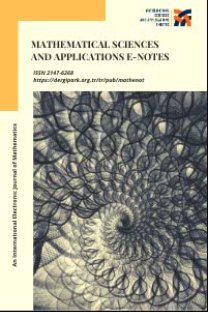Group Invariant Solutions and Local Conservation Laws of Heat Conduction Equation Arising Laser Heating Carbon Nanotubes Using Lie Group Analysis
In this study, based on the continuous transformations of Lie groups, the exact analytic solutions of the laser heating carbon nanotubes formulated by using the classical heat conduction equation with various physical properties were constructed. These solutions are the type of group invariant solutions. The constructed solutions have expanded and enriched the solution forms of this new model existing in the literature. With the help of the Maple package program, 3D, density, and contour graphs were drawn for the special values of the parameters in the solutions, and the physical structures of the solutions obtained in this way were also observed. The solutions obtained can be used in the explanation of physical phenomena occurring in cancer investigations.
Keywords:
Carbon nano tubes Lie groups, Group-invariant solutions,
___
- [1] Yaşar, E., Yıldırım, Y., & Khalique, C. M.: Lie symmetry analysis, conservation laws and exact solutions of the seventh-order time fractional Sawada–Kotera–Ito equation. Results in physics. 6, 322-328 (2016).
- [2] Yaşar, E., Yıldırım, Y., & Adem, A. R.: Perturbed optical solitons with spatio-temporal dispersion in (2+ 1)-dimensions by extended Kudryashov method. Optik. 158, 1-14 (2018).
- [3] Yaşar, E.: On the conservation laws and invariant solutions of the mKdV equation. Journal of mathematical analysis and applications, 363(1), 174-181 (2010).
- [4] Yaşar, E., & Özer, T.: On symmetries, conservation laws and invariant solutions of the foam-drainage equation. International Journal of Non-Linear Mechanics, 46(2), 357-362 (2011).
- [5] Yaşar, E., Yıldırım, Y., & Adem, A.R.: Extended transformed rational function method to nonlinear evolution equations. International Journal of Nonlinear Sciences and Numerical Simulation, 20(6), 691-701 (2019).
- [6] Hirota, R.: The direct method in soliton theory (No. 155). Cambridge University Press (2004).
- [7] Fuchssteiner, B., & Fokas, A. S.: Symplectic structures, their Bäcklund transformations and hereditary symmetries. Physica D: Nonlinear Phenomena, 4(1), 47-66 (1981).
- [8] Guo, B., Ling, L., & Liu, Q. P.: Nonlinear Schrödinger equation: generalized Darboux transformation and rogue wave solutions. Physical Review E, 85(2), 026607 (2012).
- [9] Ramani, A., Grammaticos, B., & Bountis, T.: The Painlevé property and singularity analysis of integrable and non-integrable systems. Physics Reports, 180(3), 159-245 (1989).
- [10] Bluman, G., & Anco, S.: Symmetry and integration methods for differential equations (Vol. 154). Springer Science & Business Media (2008).
- [11] He, J. H.: Variational iteration method–a kind of non-linear analytical technique: some examples. International journal of non-linear mechanics, 34(4), 699-708 (1999).
- [12] Malfliet, W., & Hereman, W.: The tanh method: I. Exact solutions of nonlinear evolution and wave equations. Physica Scripta, 54(6), 563 (1996).
- [13] Ma, W. X.: A refined invariant subspace method and applications to evolution equations. Science China Mathematics, 55(9), 1769-1778 (2012).
- [14] Olver, P. J.: Applications of Lie groups to differential equations (Vol. 107). Springer Science & Business Media (2000).
- [15] Bluman, G. W., Cheviakov, A. F., & Anco, S. C.: Applications of symmetry methods to partial differential equations (Vol. 168, pp. xx+-398). New York: Springer (2010).
- [16] Siregar, S., Oktamuliani, S., & Saijo, Y.: A theoretical model of laser heating carbon nanotubes. Nanomaterials, 8(8), 580 (2018).
- [17] Nakamiya, T., Ueda, T., Ikegami, T., Ebihara, K., & Tsuda, R.: Thermal analysis of carbon nanotube film irradiated by a pulsed laser. Current Applied Physics, 8(3-4), 400-403(2008).
- [18] Nakamiya, T., & Ebihara, K.: The Finite Element Thermal Analysis of Amorphous Silicon Thin Films Irradiated by a Pulsed Laser. The transactions of the Institute of Electrical Engineers of Japan. A, 108(10), 443-450 (1988).
- [19] Younis, M., & Rizvi, S. T. R.: Optical soliton like-pulses in ring-cavity fiber lasers of carbon nanotubes. Journal of Nanoelectronics and Optoelectronics, 11(3), 276-279 (2016).
- [20] Wang, G., Kara, A. H., Buhe, E., & Fakhar, K.: Group analysis and conservation laws of a coupled system of partial differential equations describing the carbon nanotubes conveying fluid. Romanian Journal in physics, 60(7-8), 952-960 (2015).
- [21] Muriel, C.; Romero, J.L.: First integrals, integrating factors and λ-Symmetries of second-order differential equations. J. Phys. A Math. Theor. 42, 365207 (2009).
- [22] Bai, Y. S., Pei, J. T., & Ma, W. X.: Symmetry and-Symmetry Reductions and Invariant Solutions of Four Nonlinear Differential Equations. Mathematics, 8, 1138 (2020).
- [23] A. Cheviakov.: GeM software package for computation of symmetries and conservation laws of differential equations. Comp. Phys. Comm. 176 (2007), 48-61.
- [24] Gaeta, G. C., & Morando, P.: On the relation between standard and μ-symmetries for PDEs. J. Phys. A: Math. Gen., Vol. 37, 9467-9486 (2004).
- ISSN: 2147-6268
- Yayın Aralığı: 4
- Başlangıç: 2013
- Yayıncı: -
